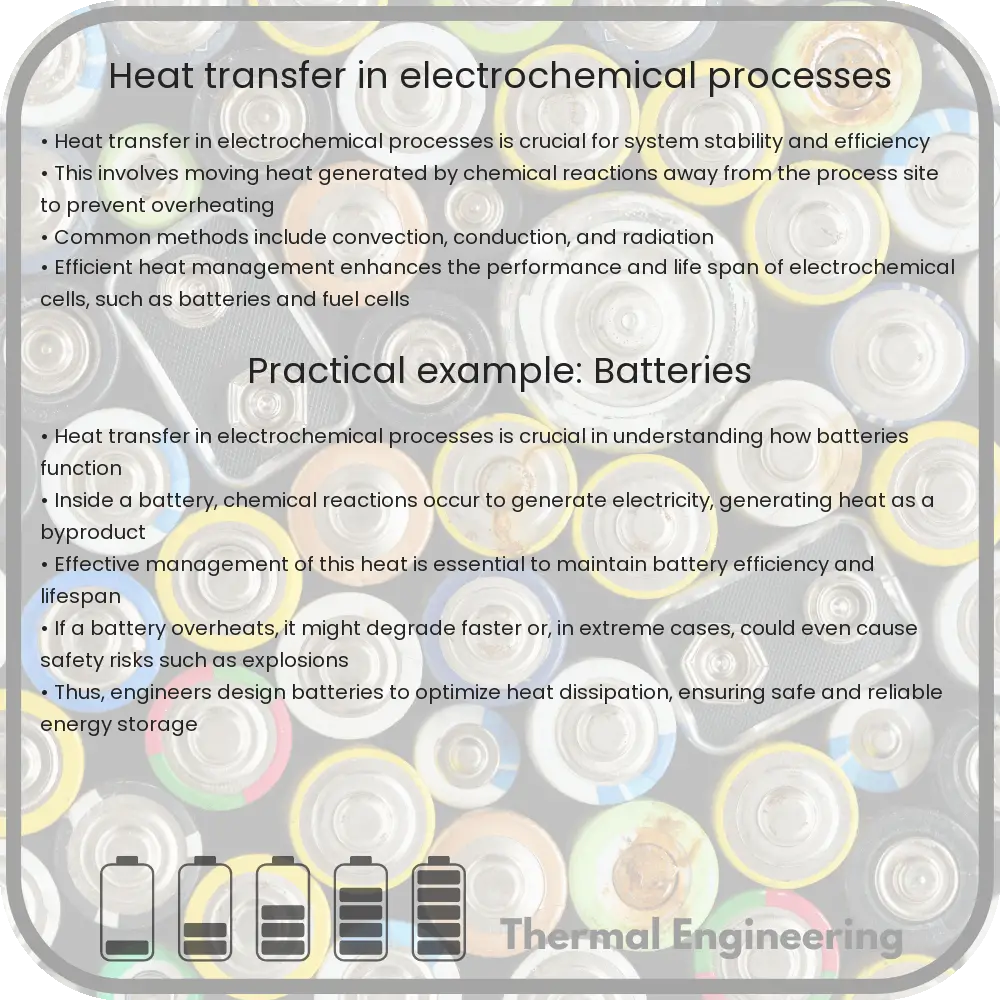Learn about the dynamics of heat transfer in electrochemical processes, crucial for enhancing device efficiency and safety in technologies like batteries and fuel cells.

Understanding Heat Transfer in Electrochemical Processes
Heat transfer in electrochemical processes is a fascinating and crucial aspect of engineering that plays a significant role in the efficiency and safety of many modern technologies such as batteries, fuel cells, and corrosion prevention systems. This article breaks down the basics of heat transfer within these systems, why it matters, and how it is managed.
Basics of Heat Transfer in Electrochemical Processes
Electrochemical processes involve the conversion between chemical energy and electrical energy. These processes are typically exothermic or endothermic, meaning they either release or absorb heat. Heat transfer in these systems can affect the performance, efficiency, and lifespan of the devices in which these reactions occur.
There are three primary modes of heat transfer:
- Conduction: Transfer of heat by direct molecular interaction. Within an electrochemical cell, heat conducts through the electrodes and the electrolyte.
- Convection: Transfer of heat by the movement of fluids (which can be liquid or gas). In battery systems, this might involve the movement of electrolyte or air cooling systems.
- Radiation: Transfer of heat in the form of electromagnetic waves. This form of heat transfer is generally less significant in electrochemical systems except at very high temperatures.
Heat Generation in Electrochemical Reactions
Electrochemical reactions involve the transfer of electrons at the electrode-electrolyte interface. These reactions can generate heat due to the following:
- Reaction Heat: Direct heat production or absorption during the electrochemical reaction (enthalpy change).
- Ohmic Heating: Heat generated by the resistance to the flow of electrons and ions through the materials which make up the cell (Joule heating). The heat generated can be estimated by the equation Q = I2R, where Q is the heat energy, I is the current, and R is the resistance.
- Overpotential Heating: Heat produced by the inefficiency in the electrodes when the actual voltage of the cell is higher than the theoretical voltage.
Thermal Management in Electrochemical Systems
Effective thermal management is crucial to maintain the performance and safety of electrochemical devices. Poor heat management can lead to reduced efficiency, battery degradation, or even hazardous conditions such as thermal runaway in batteries. Some common thermal management strategies include:
- Heat sinks and cooling fins: These are often integrated into the design of the device to help dissipate heat through conduction and convection efficiently.
- Thermal interface materials (TIM): These materials enhance heat conduction between hot spots and cooling devices.
- Cooling systems: Liquid or air cooling systems can be used to manage extreme heat conditions, particularly in large battery packs or fuel cells.
- Phase change materials (PCM): These materials absorb and release heat at specific temperatures to help regulate the temperature within the device.
Understanding the interplay of heat transfer and electrochemical processes is key to enhancing the design and functionality of many modern electrical devices. Engineers continually develop innovative solutions to handle the heat generated by electrochemical reactions, ensuring safety, stability, and performance enhancements in technologies such as renewable energy storage and electric vehicles.
By gaining a grasp of how heat is generated, transferred, and managed in these systems, both engineers and device users can improve efficiency and lifespan, contributing to more sustainable and robust energy solutions.